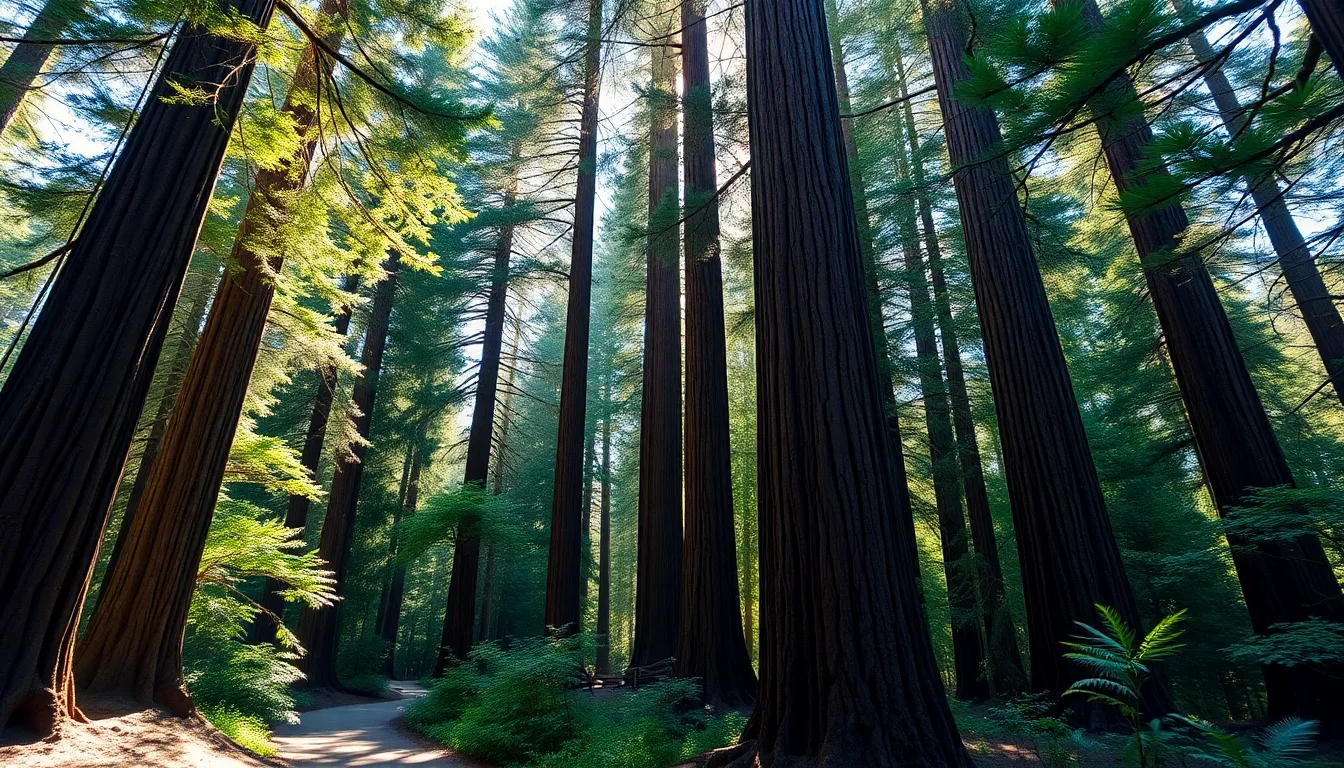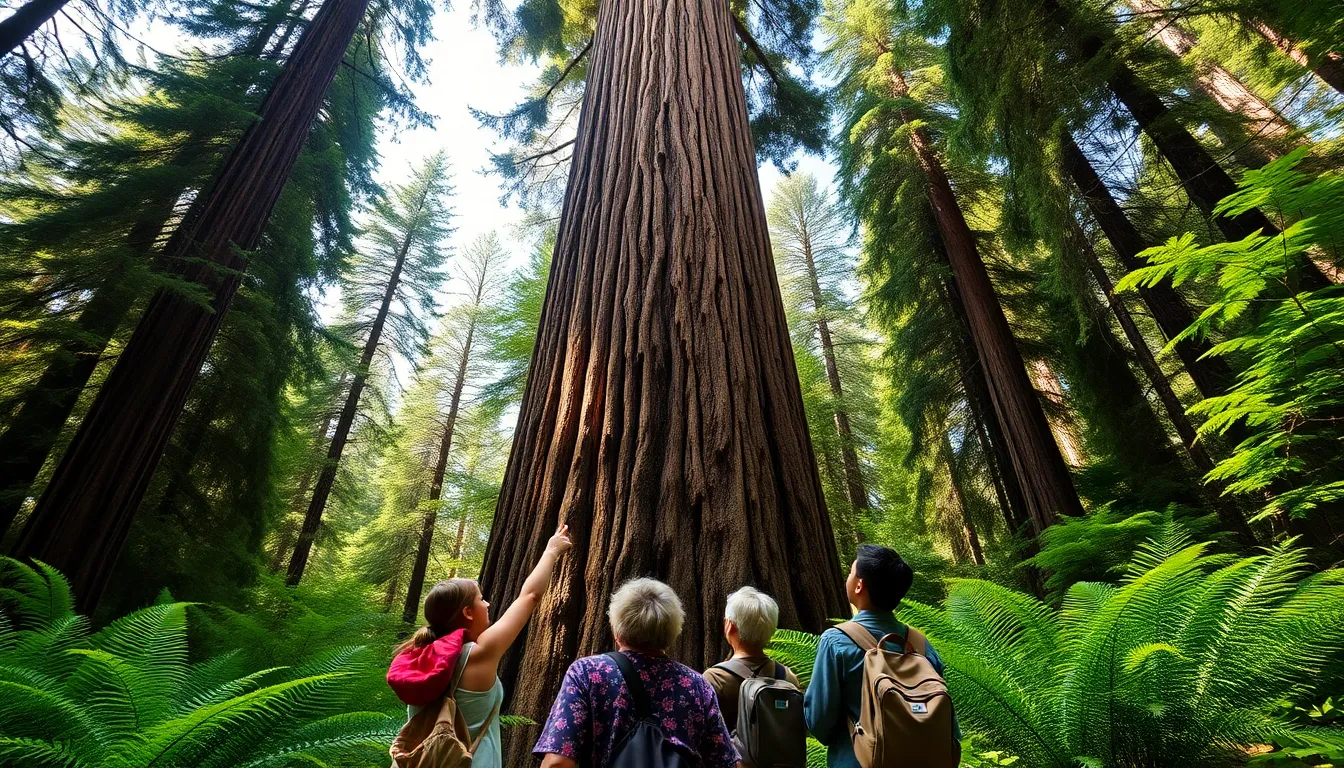Table of Contents
ToggleCalifornia’s majestic redwoods are a natural wonder that captivates visitors from around the globe. Towering high above the forest floor these ancient giants create a breathtaking landscape that feels almost otherworldly. But where exactly can one find these remarkable trees?
The redwoods primarily thrive along the northern coast of California, within a few designated parks and reserves. From the iconic Redwood National and State Parks to the serene Muir Woods National Monument, each location offers a unique glimpse into this enchanting ecosystem. Exploring these areas reveals not just the beauty of the trees but also the diverse wildlife and rich history that surround them.
Overview of California’s Redwoods
California’s redwoods showcase some of the tallest trees on earth, creating stunning landscapes that draw visitors from around the world. These ancient giants thrive in specific regions along the northern California coast, offering opportunities to explore unique ecosystems.
Types of Redwoods
California features two main types of redwoods: the Coast Redwood (Sequoia sempervirens) and the Giant Sequoia (Sequoiadendron giganteum).
- Coast Redwood: Coast redwoods grow primarily in coastal regions, reaching heights of over 370 feet and living for more than 2,000 years. Muir Woods National Monument is a notable location for observing these trees.
- Giant Sequoia: Giant sequoias mainly inhabit the Sierra Nevada mountains, known for their immense trunks and longevity, often exceeding 3,000 years. Parks such as Sequoia and Kings Canyon National Park exhibit these trees’ grandeur.
Importance of Redwoods
Redwoods play a crucial role in California’s ecosystem and conservation efforts.
- Biodiversity: They provide habitat for various species, including endangered animals like the northern spotted owl and the marbled murrelet.
- Carbon Sequestration: Redwoods absorb massive amounts of carbon dioxide, helping combat climate change and improve air quality.
- Cultural Significance: These trees hold historical and cultural importance, celebrated in local Native American stories and valued for their beauty and size by the community.
Understanding redwoods’ types and importance highlights their significance in California’s natural environment and broader ecological contributions.
Major Locations of Redwoods

Redwoods grow in several key locations across California, each offering unique experiences and breathtaking scenery. Two prominent sites are Redwood National and State Parks and Muir Woods National Monument.
Redwood National and State Parks
Redwood National and State Parks encompass approximately 139,000 acres of protected land and showcase some of the tallest trees on Earth. Located along the northern coast, this area features:
- Tallest Trees: Coast Redwoods here reach heights exceeding 370 feet.
- Diverse Ecosystems: Visitors encounter a variety of habitats, including coastal forests, riverways, and prairies.
- Wildlife Viewing: Approximately 400 species of animals inhabit the parks, including elk, black bears, and numerous bird species.
- Scenic Trails: The park offers over 200 miles of trails, facilitating hiking, biking, and exploration. Popular trails include the Lady Bird Johnson Grove Trail and Fern Canyon.
Muir Woods National Monument
Muir Woods National Monument is renowned for its ancient coastal redwoods and stunning landscapes. Situated just north of San Francisco, this site features:
- Ancient Trees: Some trees date back over 1,000 years, providing a glimpse of the past.
- Accessible Pathways: Established boardwalks and trails ensure easy access for pedestrians, catering to a wide range of visitors.
- Interpretive Programs: Educational programs focus on ecology, conservation, and the history of the redwoods.
- Biodiversity: The surrounding ecosystems support diverse flora and fauna, contributing to the area’s rich biodiversity.
These locations provide visitors with the chance to connect with nature and witness the grandeur of California’s redwoods.
Additional Redwood Areas
Several additional sites in California showcase the stunning beauty of redwoods, providing various opportunities for exploration and appreciation of these ancient giants.
Humboldt Redwoods State Park
Humboldt Redwoods State Park spans over 53,000 acres and features the largest remaining old-growth redwood forest in the world. The park is home to the famed Avenue of the Giants, a scenic highway lined with towering redwoods. This section offers numerous hiking trails, campgrounds, and picnic areas, allowing visitors to fully immerse themselves in the natural splendor. Displays of unique floral and fauna enhance the experience, affirming the ecological significance of the area.
Technological Redwood Forests
Technological Redwood Forests refer to innovative urban green spaces incorporating redwoods into landscape designs and public parks. Cities like San Francisco embrace these majestic trees in urban settings, creating pockets of nature within the metropolitan environment. This approach promotes environmental awareness, enhances urban biodiversity, and provides residents with opportunities for recreation and relaxation. These technological initiatives increase the visibility of redwoods and contribute to sustainable landscaping practices in urban areas.
Visiting the Redwoods
Visiting California’s redwoods offers a unique opportunity to immerse oneself in the grandeur of nature. With stunning views and rich ecosystems, it’s essential to plan accordingly for an unforgettable experience.
Best Times to Visit
Spring and fall represent the best seasons to visit redwood parks. Spring brings wildflowers and mild weather, while fall offers vibrant foliage and fewer crowds. Summer allows for warm temperatures but may attract larger crowds. Winter features cooler conditions, making it a peaceful time to enjoy the forests, although some trails may be less accessible. Visitors should check weather conditions and park alerts prior to their trip.
Tips for Exploring
- Stay on Trails: Staying on designated trails prevents damage to the delicate root systems of redwoods while ensuring visitor safety.
- Bring Layers: Bringing layers of clothing accommodates changing temperatures found in the forests, especially near the coast.
- Start Early: Starting early helps avoid crowds and provides opportunities for wildlife sightings during morning hours.
- Pack Water and Snacks: Packing enough water and snacks supports hydration and energy, especially on longer hikes.
- Use Guided Tours: Utilizing guided tours offers insightful information on redwood history, ecology, and conservation efforts from knowledgeable park rangers.
- Respect Wildlife: Respecting wildlife by observing from a distance minimizes stress on animals and ensures a safer experience for visitors.
These recommendations enhance the experience of exploring California’s redwoods, ensuring visitors appreciate their beauty and ecological significance.
Conservation Efforts
Efforts to conserve California’s redwoods focus on protecting their unique ecosystems and fostering community involvement in their preservation. These initiatives aim to ensure the vitality and longevity of these ancient giants.
Protecting the Ecosystem
Organizations, such as the National Park Service and nonprofit conservation groups, engage in various activities to safeguard redwood ecosystems. They implement controlled burns, enhance habitat restoration, and monitor forest health to combat invasive species.
Thinning overcrowded stands promotes growth and resilience against pests and diseases. Collaborative projects with local agencies focus on preserving water quality and maintaining biodiversity within these forests.
Research studies quantify carbon sequestration benefits, demonstrating the essential role of redwoods in combating climate change. These findings support policies that prioritize redwood protection, ensuring sustainable management of these critical habitats.
Community Involvement
Community involvement plays a vital role in redwood conservation efforts. Local volunteers assist in tree planting initiatives, habitat restoration projects, and educational outreach.
Schools and organizations offer programs that teach the importance of redwoods, fostering appreciation among youth. Events like “Redwood Days” promote stewardship by bringing together advocates for fundraising and awareness.
Social media campaigns raise awareness of conservation issues, inspiring public support for legislative actions to protect redwood forests. Engaging local communities fosters a sense of pride and responsibility towards these natural treasures, ensuring their protection for future generations.
California’s redwoods stand as a testament to nature’s grandeur and resilience. These ancient trees not only provide breathtaking views but also play a crucial role in maintaining ecological balance. By visiting the parks and reserves that house these magnificent giants, individuals can connect with nature and contribute to conservation efforts.
The ongoing commitment to protect these ecosystems ensures that future generations will continue to experience the wonder of the redwoods. Whether it’s through hiking the trails or participating in community initiatives, every effort counts in preserving this vital part of California’s natural heritage. Embracing the beauty and significance of the redwoods fosters a deeper appreciation for the environment and its intricate web of life.








